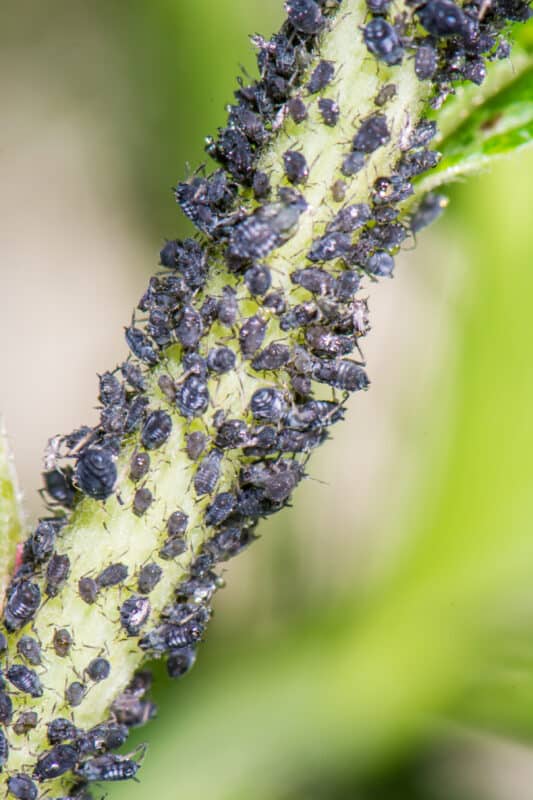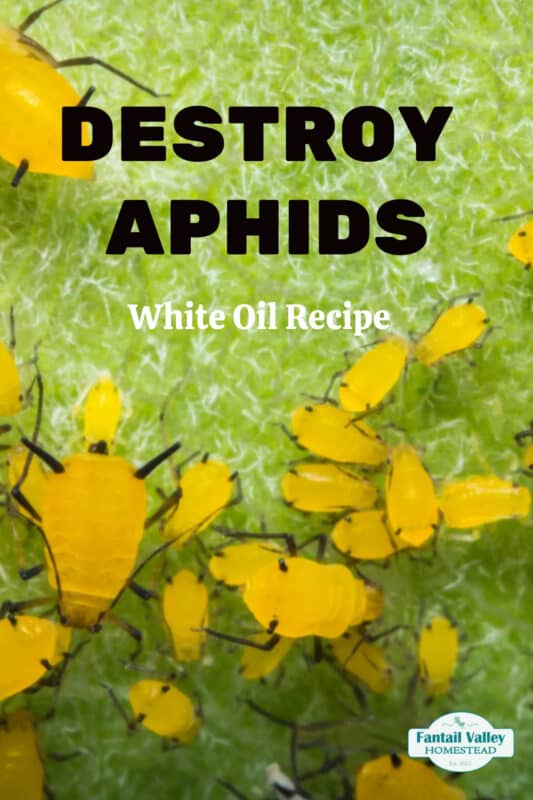Aphids, also known as plant lice, are small insects that feed on the sap of various plants, including cucumbers. These pests can be a major problem for cucumber farmers and home gardeners alike, as they can cause deformities in the cucumbers and significantly reduce the overall yield of the plants and in bad infestations can kill the plants.
In this article, we will discuss the different types and colors of aphids that can be found on cucumbers, as well as effective methods for controlling and treating heavy infestations.
Please read: This information is provided for educational purposes only and is not intended to treat, diagnose or prevent any disease. We encourage you to make your own health care decisions in partnership with a qualified health care professional.
This post contains affiliate links, this means at no extra cost to you, we make a commission from sales. Please read our Disclosure Statement
Types of Aphids
There are several different types of aphids that can be found on cucumbers, including the melon aphid. Melon aphids are small, dark green or black insects that are often found on the stems and leaves of cucumber plants.
They have a soft, pear-shaped body and long antennae. In addition to feeding on the sap of the plants, melon aphids can also transmit diseases from one plant to another.
Another type of aphid that can be found on cucumbers is the cotton aphid. These insects are small and pale green, with a soft, round body. They are often found on the stems and leaves of the plants, and can transmit diseases such as cucumber mosaic virus.
Colors of Aphids
Aphids come in a variety of colors, including green, black, brown, grey, yellow and pink.
The most common aphids found on cucumbers are green and black. Green aphids are small and pear-shaped, with a shiny, translucent body. Black aphids are slightly larger and have a more rounded body shape.
Both of these types of aphids have long, thin antennae and can be found on the undersides of cucumber leaves and on the stems of the plants.
Why aphids attack plants
Aphids attack plants in order to feed on the sap that flows through the plant’s vascular system. The aphids insert their needle-like mouthparts into the plant’s stems and leaves and extract the sap, which is rich in sugars and nutrients.
As they feed, the aphids excrete a sticky substance known as honeydew, which can attract other pests and encourage the growth of sooty mold.
How to prevent aphids
There are several things that you can do to discourage aphids from attacking your plants:
- Keep your plants healthy: Aphids are attracted to stressed or damaged plants, so it’s important to keep your plants healthy and well-maintained. Water your plants regularly and provide them with the nutrients they need to grow.
- Remove infected plants: If you notice that a particular plant is heavily infested with aphids, it may be best to remove it from your garden. This will help to prevent the aphids from spreading to other plants.
- Introduce natural predators: As I mentioned earlier, ladybugs and parasitic wasps are natural predators of aphids. Planting flowers that attract these beneficial insects can help to keep the aphid population under control.
- Use physical barriers: Covering your plants with fine mesh netting or row covers can help to keep aphids and other pests away.
- Use natural or chemical pesticides: If the infestation is severe, you may need to use a natural or chemical pesticide to kill the aphids. However, be aware that these pesticides can also harm beneficial insects and should be used with caution.
By following these tips, you can discourage aphids from attacking your plants and help to keep your garden healthy and thriving.
Brix content and aphid damage
Aphids have a limited ability to digest the sugars present in plants. Some research has suggested that aphids may struggle to digest plants with a high brix content, especially if the brix level is above 12%.
Aphids extract the sap from plants using their needle-like mouthparts and process it in their gut using enzymes. However, the gut of an aphid is relatively simple and is not able to break down all of the complex sugars present in the sap. As a result, aphids excrete a large portion of the sugars they consume as honeydew, a sticky substance that is high in sugars.
It’s worth noting that while a high brix content may make it more difficult for aphids to digest the sugars in a plant, it does not necessarily mean that the plant will be less attractive to aphids.
Aphids are attracted to the sap of plants for the nutrients and moisture it provides, and they will continue to feed on a plant even if they are unable to fully digest the sugars present in the sap.
Aphid life cycle
The life cycle of aphids varies depending on the specific species, but most aphids have a similar life cycle.
Aphids reproduce rapidly and can have several generations in a single season. In many species, the females give birth to live young and do not need to mate in order to reproduce. This process, known as parthenogenesis, allows the population of aphids to grow quickly.
The life cycle of an aphid begins as an egg, which is laid on a suitable host plant. When the egg hatches, the young aphid, known as a nymph, begins to feed on the sap of the plant. As it grows, the nymph sheds its exoskeleton several times until it reaches adulthood.
Adults can be either male or female, and they continue to feed on the sap of the plants. When the females are ready to reproduce, they give birth to live young, which are usually mostly female.
Aphids can complete their life cycle in as little as two weeks, depending on the temperature and the availability of food. As the weather becomes colder, some species of aphids will produce eggs that can survive the winter and hatch when the weather warms up in the spring. This allows the population of aphids to survive from one year to the next.
Can Aphids Fly?
Many species of aphids are able to fly in their mature state. Some species of Aphids have wings, and they use them to disperse and colonize new host plants. Some species of aphids are more adept at flying than others, and some may rely more on other methods of dispersal, such as crawling or hitching a ride on a bird or other animal.
Aphids are often attracted to plants that are stressed or damaged, and they may use their wings to move from one plant to another in search of a suitable host. They can also be carried long distances by the wind or by other insects.
In general, aphids are more likely to fly when the population becomes overcrowded or when environmental conditions become unfavorable. For example, aphids may take to the air in search of new host plants if their current food source becomes scarce or if the weather becomes too hot or dry.
Control and Treatment Options for an Aphid Infestation
If you notice an infestation of aphids on your cucumber plants, there are several methods you can use to control and treat the problem. One option is to use a natural pest control method called “white oil.” White oil is a mixture of either vegetable or mineral oil and soap that can be used to suffocate and kill the aphids. You can buy white oil concentrates or you can make your own easily at home.
To make white oil, mix together four cups of either vegetable or mineral oil and one cup of liquid soap.
Shake this well and it will turn white. Store this in a sealed bottle out of the light, it will last for a very long time in this state. this is your concentrate mixture.
How to use white oil to control aphids
Choose a sunny day with no wind to apply the white oil, as the oil will be most effective when applied to warm, dry plants.
Mix the white oil according to the instructions on the label. If you are using the home made mixture, you can use 1/2 a cup for each 5 liters (5 quarts) of water. For smaller volumes, use 2 tablespoons in a liter (one quart). Shake well before use.
Spray the mixture onto the affected plants, making sure to cover the tops and undersides of the leaves, as well as the stems and branches.
Use a fine mist spray to apply the mixture, as a heavy application may cause the leaves to burn.
Reapply the white oil every 7 to 10 days, or as needed, until the aphid infestation is under control. For very heavy infestations, it can be used every second day for 2 weeks before moving to a weekly or bi-weekly application.
As an alternative to spraying, you can also apply white oil using a handheld or backpack sprayer, which will allow you to cover larger areas more efficiently.
By following these steps, you can effectively use white oil to control aphids and protect your plants from these harmful insects.
Using beneficial insects to control aphids
Another option for controlling aphids is to use parasitic wasps. These wasps lay their eggs inside the aphids, and the wasp larva feed on the aphids from the inside out. Once the wasp larva have matured, they will emerge from the aphid’s body and spin a cocoon, eventually emerging as adult wasps.
Ladybugs are another effective method for controlling aphids on cucumber plants. These beneficial insects are natural predators of aphids and can help to reduce the population of these pests. To attract ladybugs to your garden, plant flowers such as dill, fennel, and yarrow, which ladybugs are attracted to.
You can buy both of these insects from some online companies who will ship the eggs to you.
Additional Methods for Controlling Aphids on Cucumbers
In addition to using natural pest control methods such as white oil, parasitic wasps, and ladybugs, there are several other methods that can be effective in controlling aphids on cucumber plants.
One option is to use insecticidal soap. This is a specially formulated soap that is designed to kill aphids and other soft-bodied insects. To use insecticidal soap, mix together a solution of water and soap according to the manufacturer’s instructions. Spray the solution onto the affected plants, making sure to cover the undersides of the leaves where the aphids are often found.
Another option is to use horticultural oil. This is a type of oil that is applied to the plants to smother and kill the aphids.
Horticultural oil can be effective in controlling aphids, but it can also be harmful to beneficial insects such as bees and ladybugs. Be sure to follow the manufacturer’s instructions carefully when using horticultural oil, and avoid applying it when bees are present.
If you have a severe infestation of aphids on your cucumber plants, you may need to use a chemical insecticide. There are several insecticides available that are effective in controlling aphids, including pyrethroids and neonicotinoids.
These insecticides can be harmful to beneficial insects and should be used with caution. Be sure to follow the manufacturer’s instructions carefully when using chemical insecticides, and consider using natural pest control methods as a first line of defense.
In summary, there are several methods that can be effective in controlling aphids on cucumber plants. These include natural pest control methods such as white oil, parasitic wasps, and ladybugs, as well as chemical options such as insecticidal soap and horticultural oil.
If you have a severe infestation of aphids, you may need to use a chemical insecticide. However, be sure to follow the manufacturer’s instructions carefully and consider the potential impact on beneficial insects before using any chemical pest control methods.



